The importance of timekeeping has endured from the earliest forms of civilisation to the present day. For centuries, the use of various devices to tell time accurately has facilitated Middle Templars in conducting their diverse professional activities. In this edition, we highlight historic timekeeping devices across the Inn – some which one can spot in plain sight, some more hidden away – shedding light on the changes surrounding these delicate instruments.
Many Middle Templars have seen the sundial situated at the southern tip of the garden, a familiar sight since its erection in 1830. Records show that in 1772 a mathematical instrument maker called Tycho Wing received £2 18s for ‘repairing the figures, letter and coats of arms’ on an 18-inch horizontal sundial – a style of sundial commonly placed outdoors in a garden – suggesting the existence of an earlier garden sundial. The current sundial, measuring the same size, was crafted by William Cary, an eminent map, globe and instrument maker in the Strand, with engraving recut by Newton & Co. in 1878.
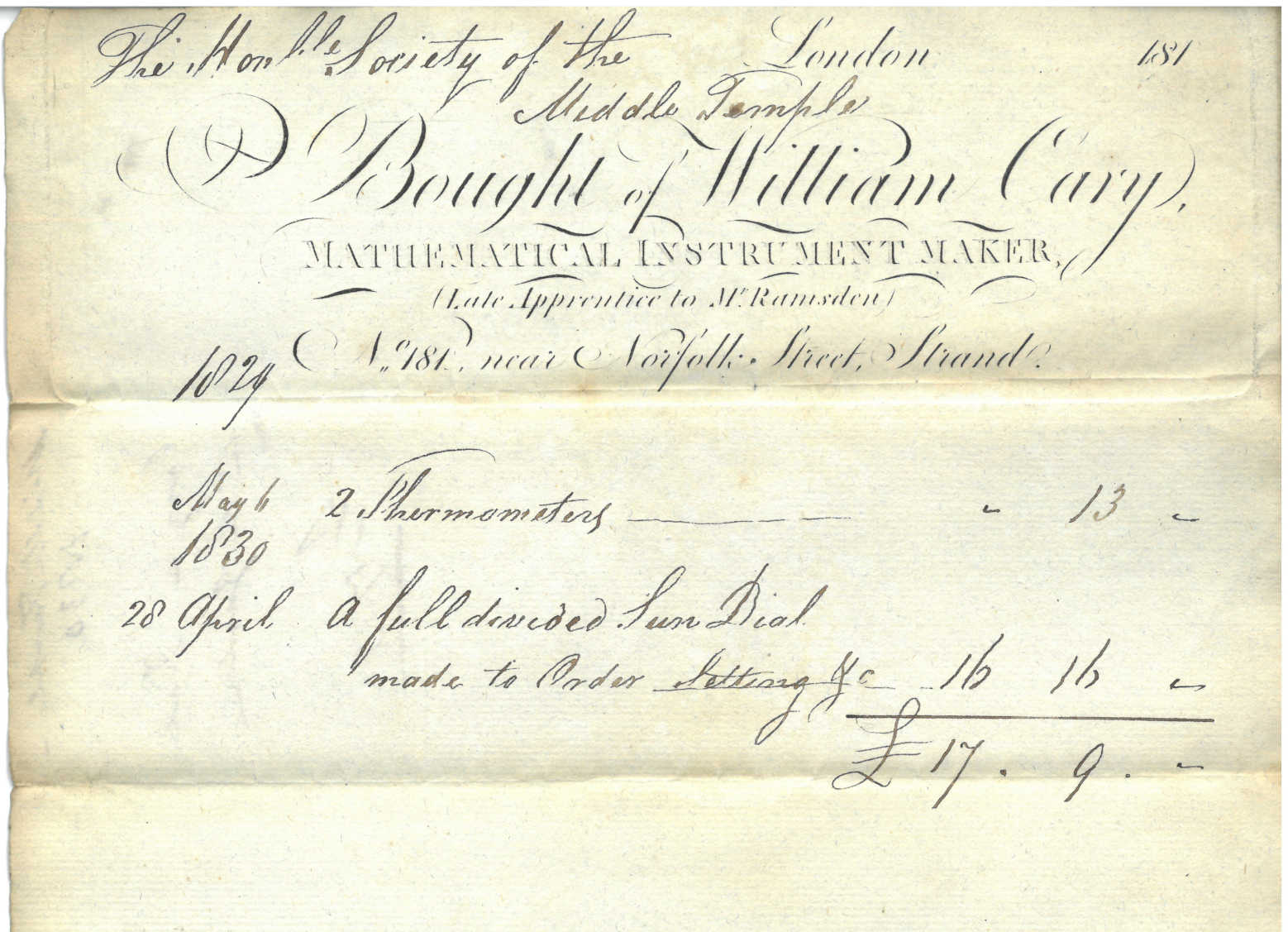
Receipt showing £16 16s paid to William Cary for making a full divided sundial, 1830 (MT/21/2/6)
The sundial’s base plate, on which the pointer casts a shadow to tell the time, is engraved with rings denoting cardinal directions and Roman numerals. Designed for more accurate and sophisticated time reading, Cary’s creation instructs readers on when to read the time ‘faster’ or ‘slower’ in certain months to compensate the difference in sun and clock time. The sundial also indicates in which city of the world the solar noon, the precise moment when the sun reaches its highest point in the sky, is currently taking place. The concept of solar noon was helpful to sailors and navigators in determining their position at sea.
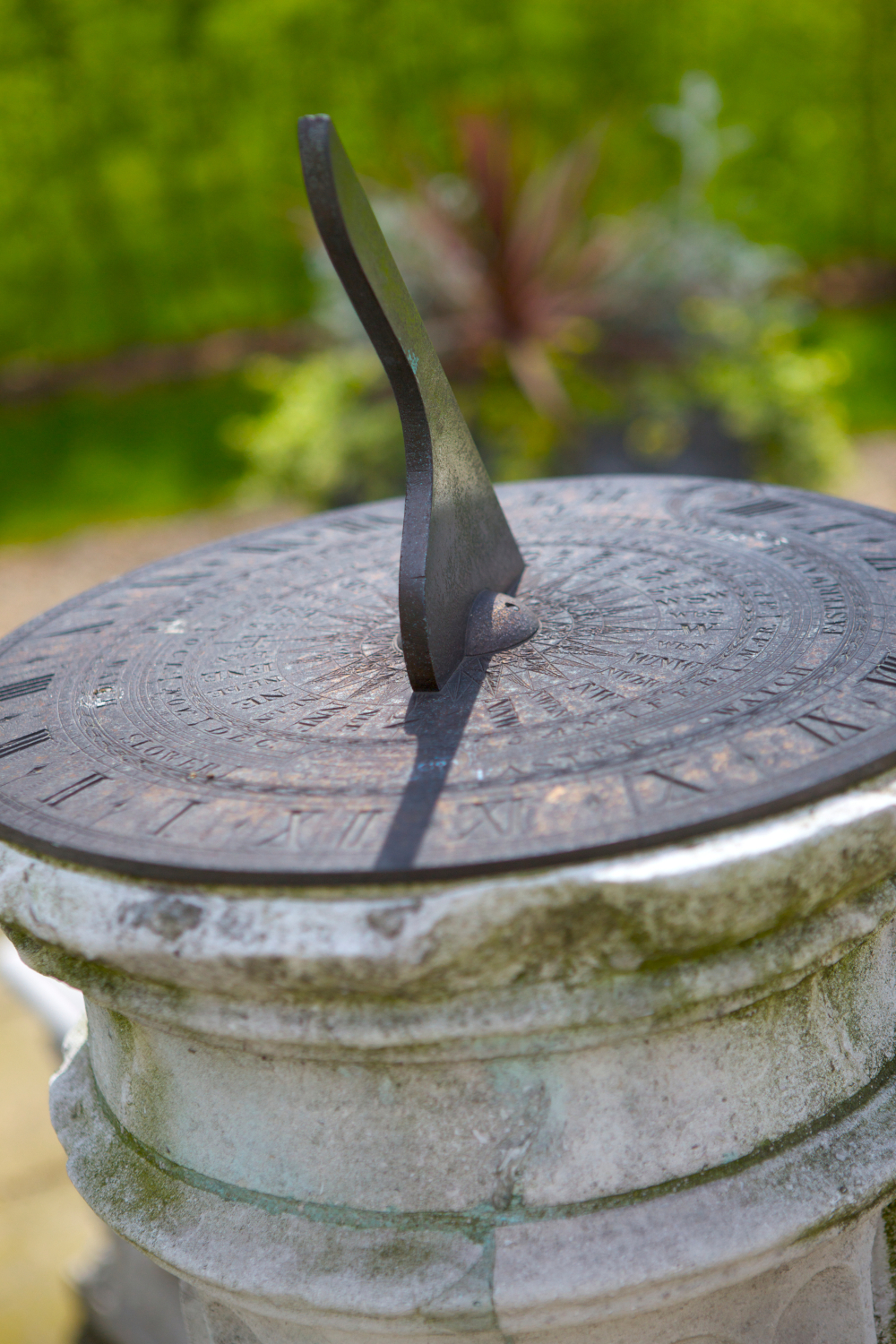
Sundial in the Middle Temple garden (MT/19/PHO/10/17/18)
The garden sundial is not the oldest one to be found today within the Inn’s precinct, where one can spot another style of sundial, this time mounted up high. The Inn has two of these vertical sundials. The older one, located just opposite the north side of Hall, dates back to 1685; it displays the initials of the then Treasurer, William Thursby, and a motto of particular relevance to the legal profession: ‘Discite Justitiam Moniti (Be warned, learn justice)’. Just a year later, the other sundial in Pump Court, which cost £6 5s, was installed during the Treasurership of Oliver Montagu.
Sundial at Fountain Court, opposite the north side of Hall
At one time, a third vertical sundial was found at the Inn, overlooking Middle Templars in Brick Court. Sadly, it likely met its demise along with the building during the bombing of the Second World War. This lost sundial, as depicted in an illustration in the Archive, was decorated with the initials of the 1872 Treasurer Thomas Chambers and the lamb and flag emblem, along with an enigmatic inscription that read ‘Shadows we are and Like shadows depart’, which is still visible below the Pump Court sundial.
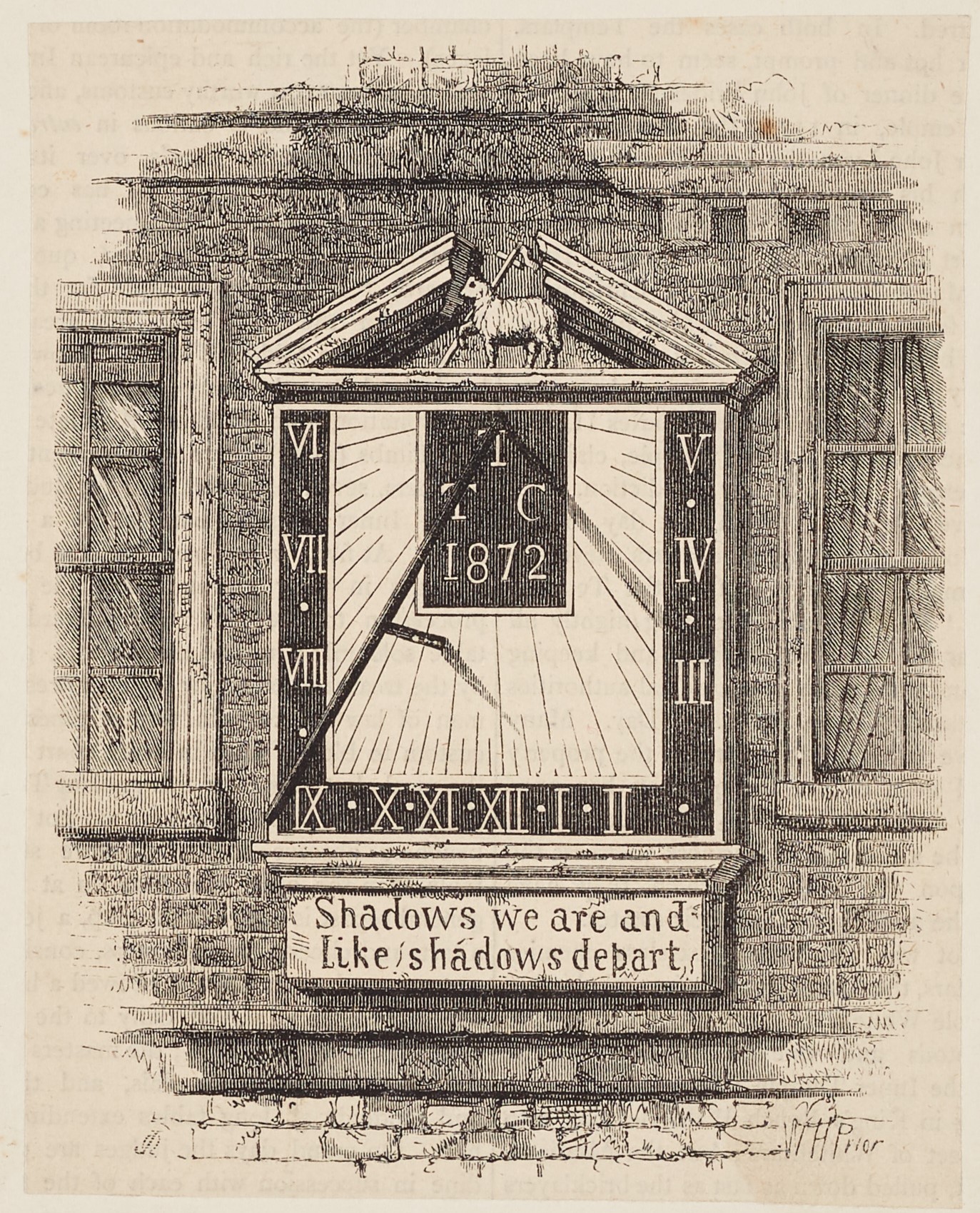
Illustration of the sundial at Brick Court, signed W. H. Prior, 1874 (MT/19/ILL/E/E2/2)
Somewhat unexpectedly, the sight of sundials at the Inn extends beyond outdoor locations – those with an observant eye might have noticed its appearance in one of the stained glass armorials in Hall, positioned above the minstrels’ gallery. The stained glass features a rectangular-shaped sundial resting atop of the coat of arms of Sir Nicholas Hyde, Treasurer 1625, and an inscription commemorating his being made Chief Justice of the King in 1626/7. The symmetrical arrangement of the hour lines on the sundial suggests that this stained glass may have been originally installed on a south-facing window, allowing it to indicate the time accurately, if its purpose was more than mere decoration.
Stained glass armorial of Sir Nicholas Hyde in Hall, made by Baptista Sutton in 1627
While sundials remained popular timekeeping devices for Middle Templars, the Inn was quick to embrace another kind of instrument offering greater practicality and accuracy – mechanical clocks. Among the many acquired throughout its long history, the large turret clock mounted on the exterior wall of Hall stands out as the most visually remarkable. An early reference to a turret clock dates to the 1667 Treasurer’s receipt book, which records a payment of £45 to William Clement, later the Master of the Worshipful Company of Clockmakers, for making and setting a clock over the Hall porch.

Receipt showing £10 paid to William Clement, in part of the full payment amounting to £45, for making a turret clock, 22nd May 1667 (MT/2/TRB/25)
Clement’s clock might have remained in use until 1745, when the Inn engaged another clockmaker Nathaniel Delander II to alter it into an ‘upright pendulum style’ with a gilt brass dial plate, which cost £52 11s 5p. In 1810, Handley & Moore received £84 for supplying an eight-day turret clock ‘made upon the best principle’. This was followed by a more radical change in 1832 when a Neo-Tudor entrance tower to Hall, designed by the architect James Savage, was erected, with alterations to the clock carried out by Yonge & Son.
Before assuming its contemporary look, the turret clock underwent several major repairs and transformations, including a faithful restoration after the Second World War. Although no plans of the above clocks survive in the Archive, the evolving faces of the turret clock can be observed in the below illustrations depicting the north side of Hall from different time periods.
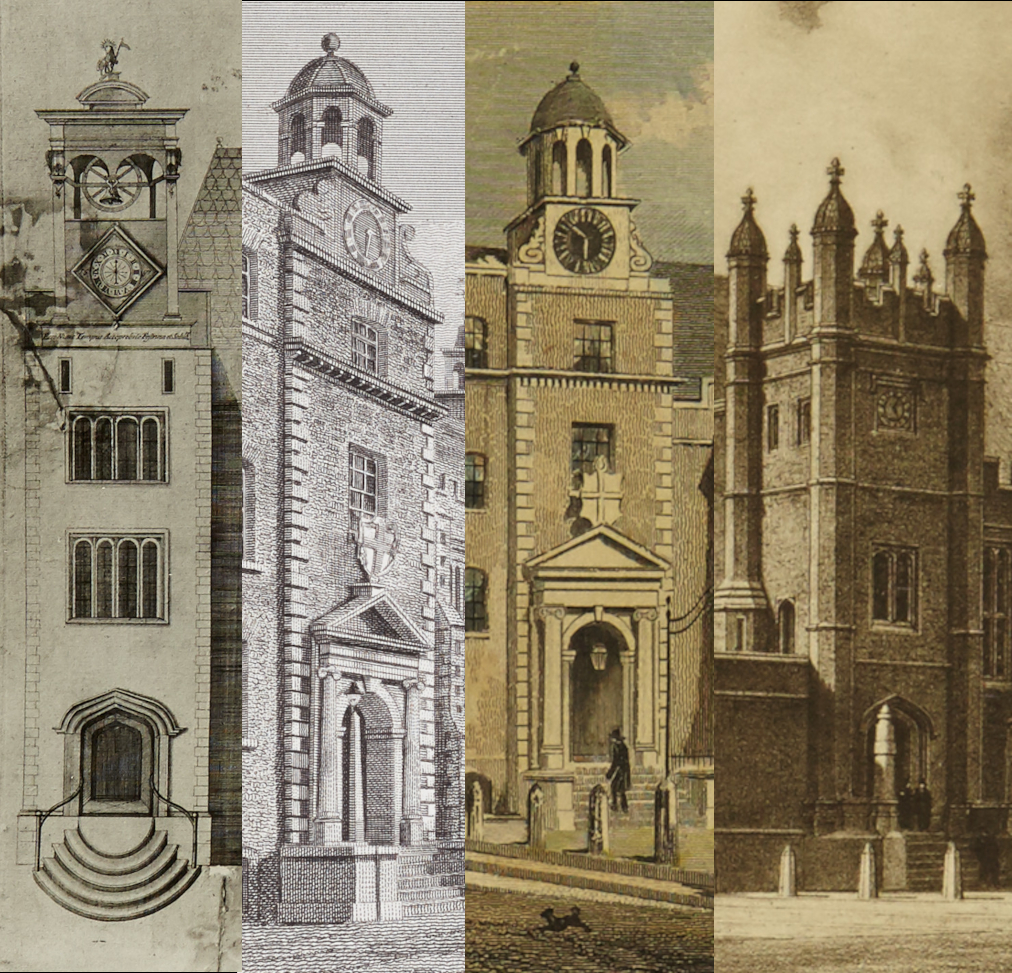
A collage of four illustrations depicting the turret clock on the north side of Hall in 1701, 1804, 1828 and c.1832 (MT/19/ILL/D/D1)
Despite the increased precision in timekeeping, the mechanical construction of clocks meant they required more care than sundials to perform at their best. An eight-day turret clock, for example, ran on a cycle of eight days and needed servicing towards the end of its cycle for its continued operation. This regular maintenance, known as clockkeeping, involved various tasks such as winding, cleaning, polishing, repairing and fitting with new accessories.
Until the late 18th century, keeping of the clocks at the Inn was under the purview of its butlers and surveyors, after which it was outsourced to professional clockmakers. One of the prominent London clockmakers that worked for the Inn included Charles Frodsham, who was appointed for a salary of £5 per annum in 1857, not long after he had made a name for himself as the clockmaker for Queen Victoria.
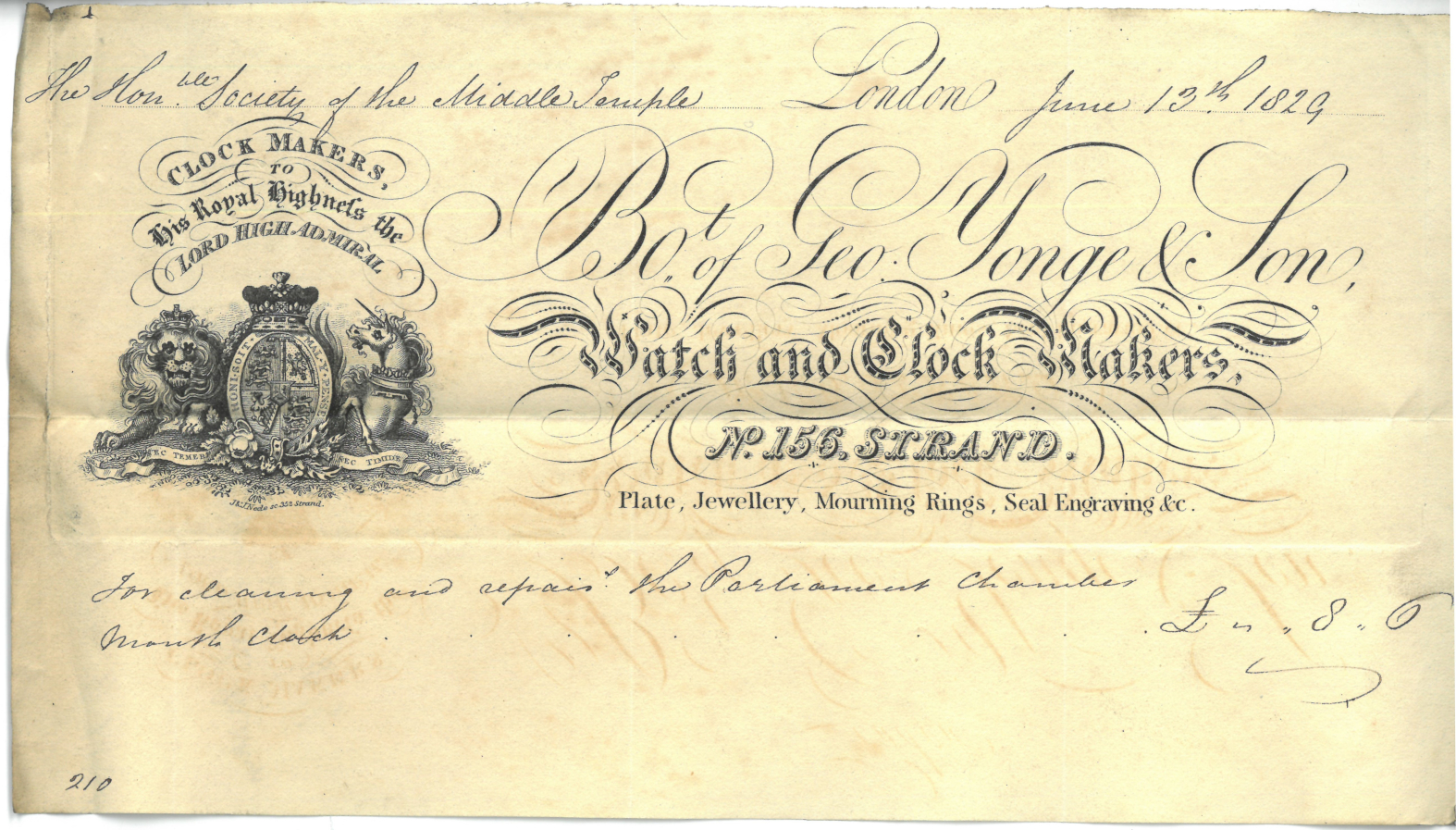
Receipt showing £8s 9p paid to George Yonge & Son for cleaning and repairing a month-clock in the old Parliament Chamber, 13th June 1829 (MT/2/TUT/79)
Records show that clockkeeping at the Inn was not always executed to the satisfaction of its members. In 1809, Parliament noted a complaint regarding the turret clock, ordering the dismissal of the clockkeeper if the clock was not properly attended to. Another complaint letter was received in 1838, carrying the complainant’s discontent that the turret clock was generally ‘never to its time’ and had caused them to lose ‘many an hour’.
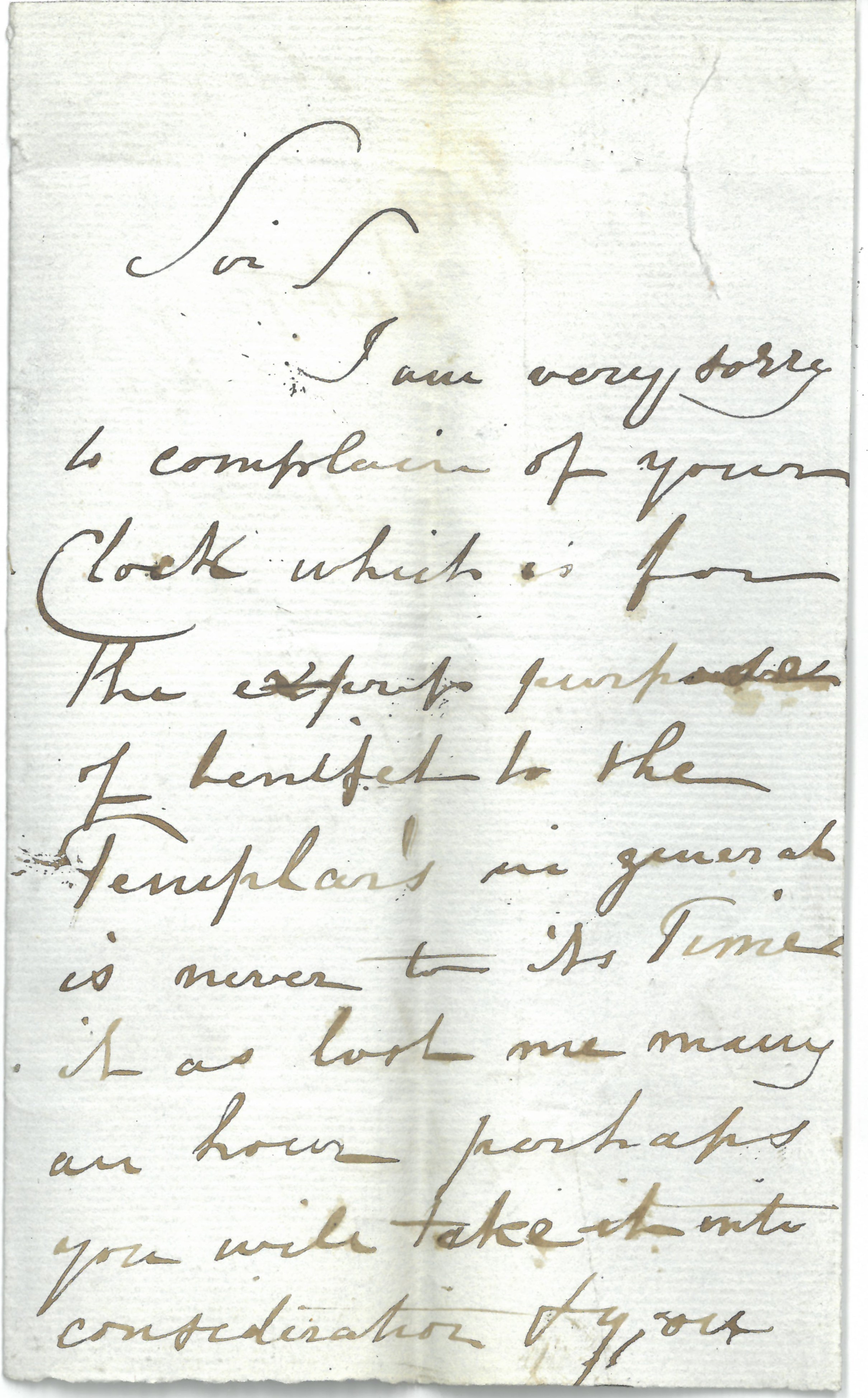
Extract of a letter to the Inn complaining the timekeeping accuracy of its turret clock, [1838] (MT/1/LIN)
In the following decades the demand for timekeeping devices and clockkeeping at the Inn surged alongside its growing business and membership. More clocks were purchased and placed at various indoor locations for the use of staff and members.
A 1924 clockmaker’s receipt offers a glimpse into the variety of clocks that the Inn once owned. Apart from the turret clock, the devices serviced included dials in the general office, kitchens, glass room and porter’s lodge; an English striking bracket timepiece in the Parliament Chamber; two French striking clocks in the Treasurer’s Room and Smoking Room; an English bracket timepiece in the old Library; and a ‘tell-tale’ timepiece, which might have been used by watchmen to record the time of visiting a station on their rounds.
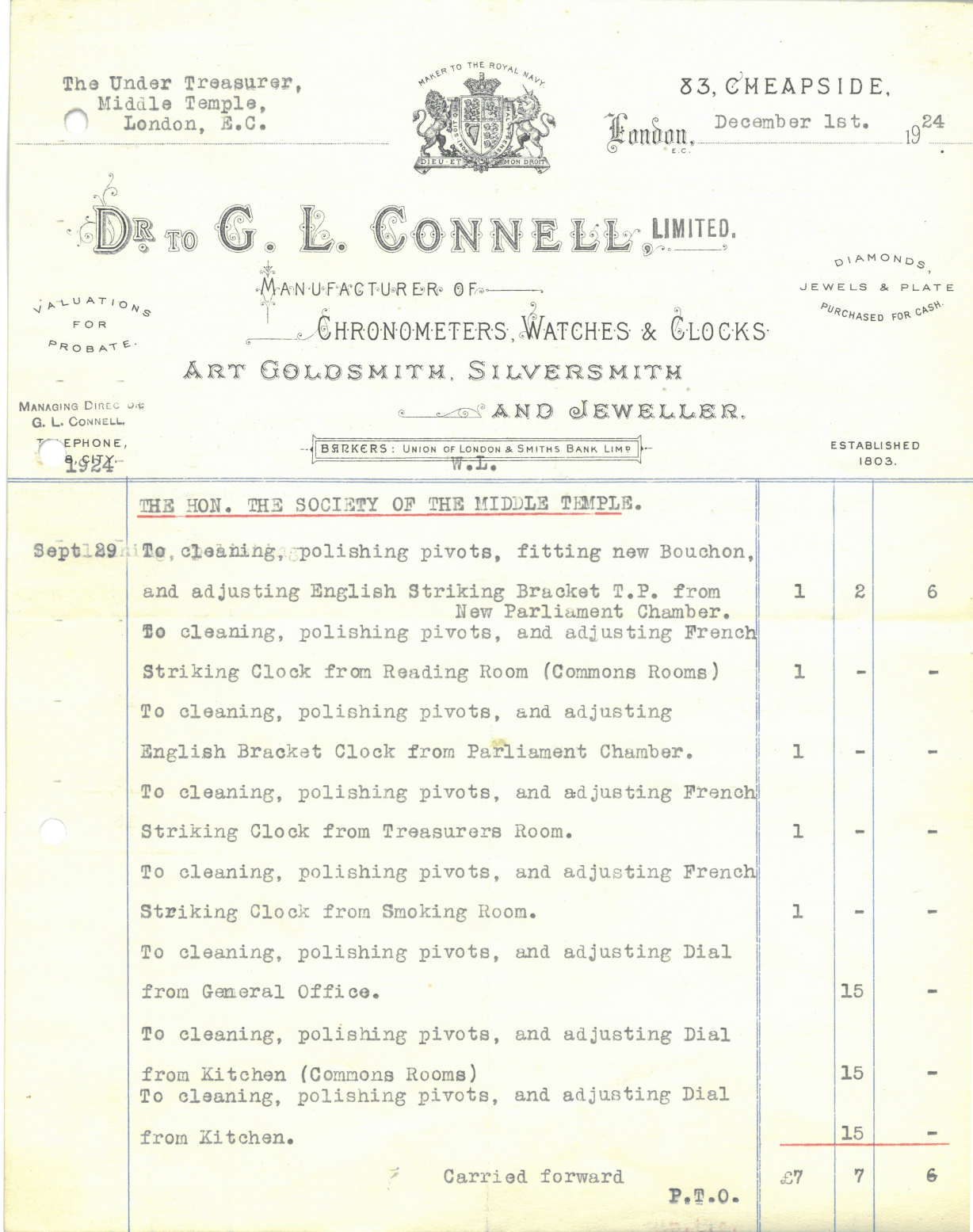
Extract of a receipt recording the clockkeeping service provided by G. L. Connell, 1st December 1924 (MT/2/TRB/286)
On rare occasions, the sight of timekeeping devices at the Inn strikes the viewer with subtlety. Such is the case for the Inn’s portrait of Sir John Bramston, Lent Reader 1622, which features an exquisite mid-17th century tabletop timepiece with a dome top at the bottom right. Its symbolic meaning in the portrait, if any, remains uncertain, but the resonance between its gilt finishing and the shimmering livery collar worn by the sitter, a testament to Bramston’s position as Lord Chief Justice, is no doubt a visual delight.
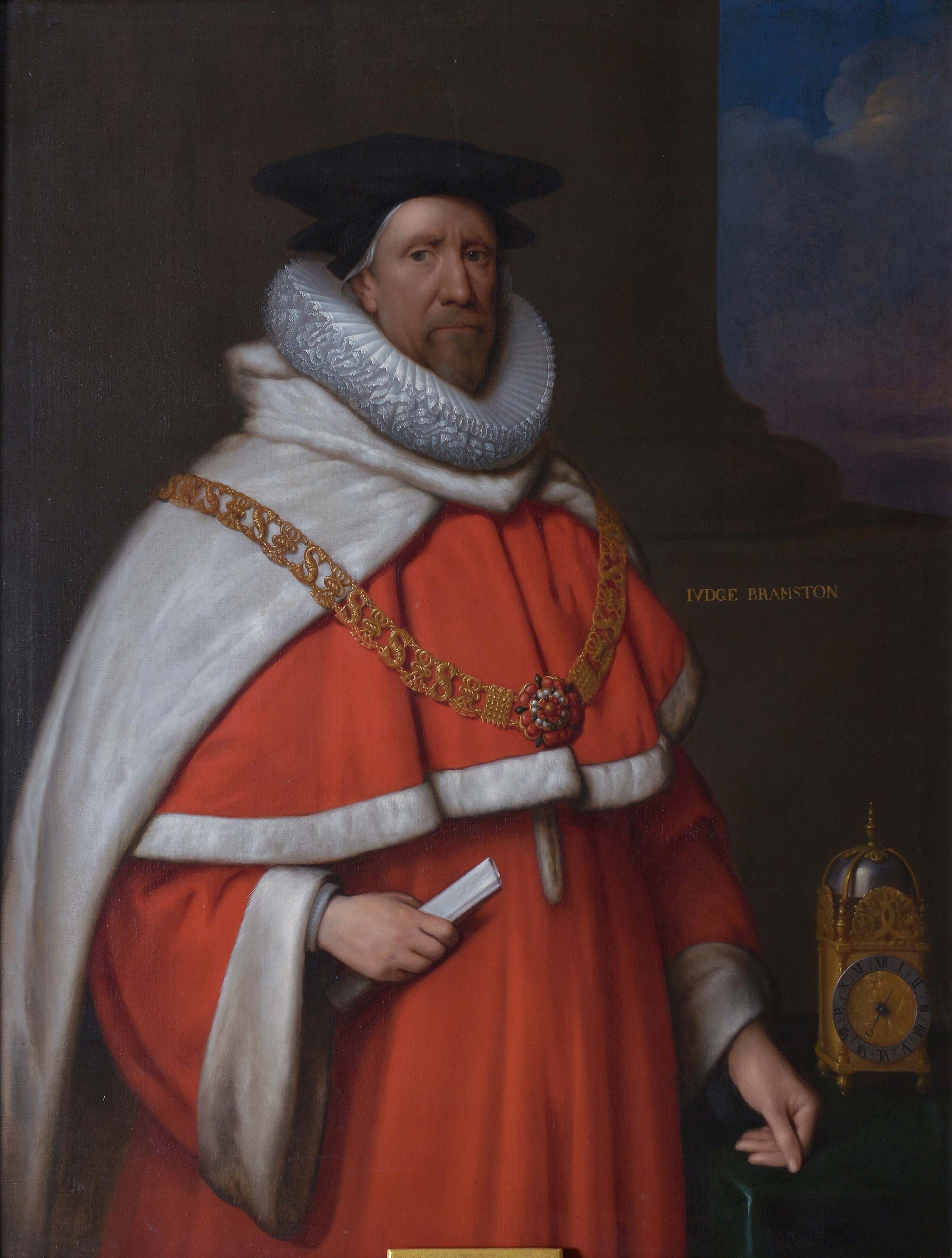
Portrait of Sir John Bramston, currently hanging in the corridor leading to the Prince’s Room, painted in the 17th century (P.048)
Today, a number of historic clocks still adorn the interior of the Inn, although they now serve largely ornamental purposes. Standing at the corner of the Prince’s Room is a longcase clock made by Joseph Knibb, a famous clockmaker known for making several fine clocks for Charles II. Unfortunately, according to a 1980 valuation report, this clock would have been ‘one of the finer clocks Knibb produced’ had its moving parts not been subsequently converted and replaced.
A similar longcase clock can be found in the Queen’s Room, sporting a more decorative style with its embellishment of pagodas and flowering trees in a japanned finish. This elegant clock was presented to the Inn as a gift by the 1938 Treasurer Sir Anthony Hawke upon his stepping down from the position, and has added to the room’s charm ever since. Besides the Bench Apartments, some clocks are also safely stored in the Archive – most notably two late Victorian clocks by E. Dent & Co., whose original founder, Edward Dent, constructed the clock in the Houses of Parliament now known as ‘Big Ben’.
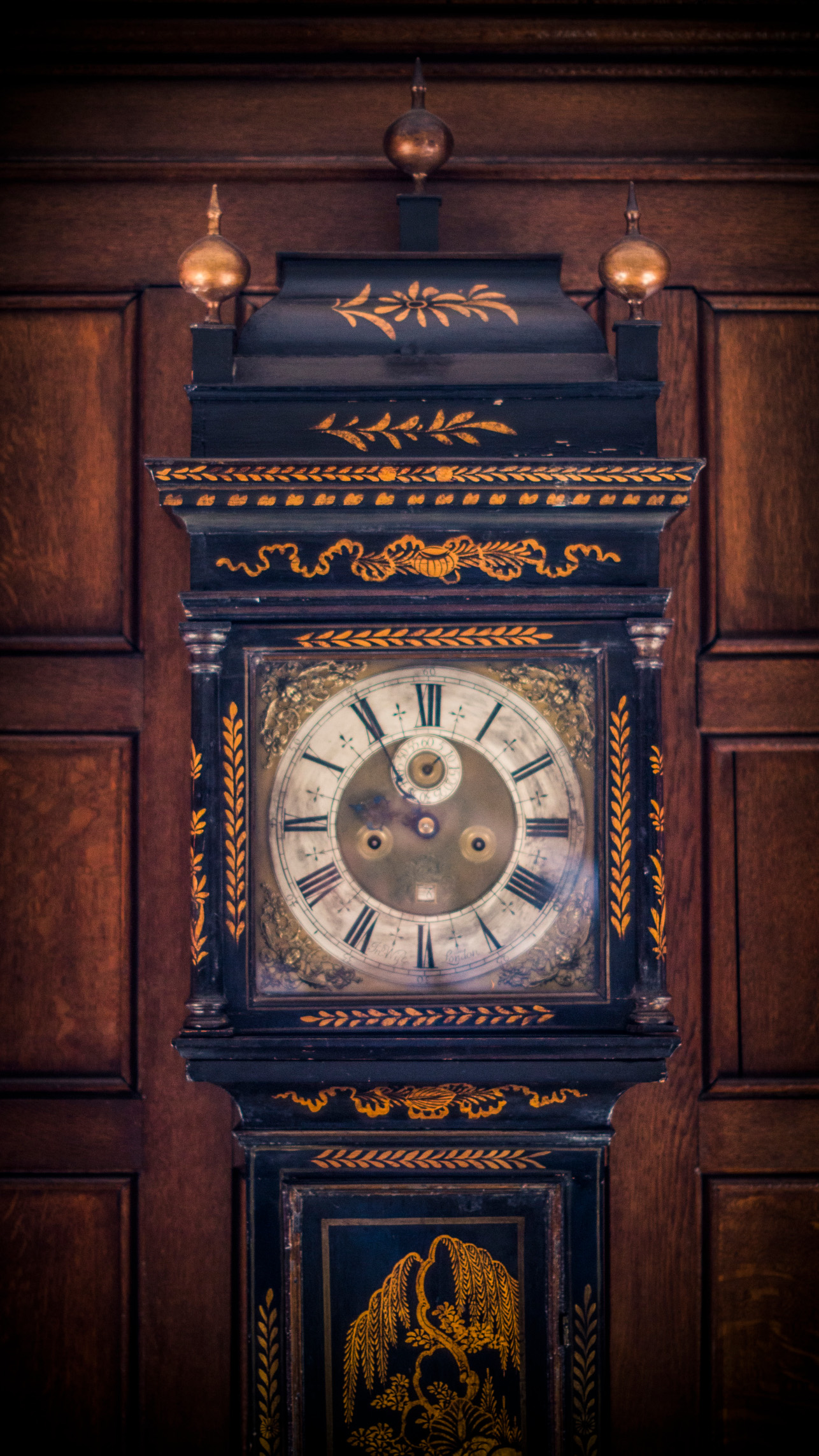
Close-up of the longcase clock in the Queen’s Room (MT/19/PHO/14/9)
Close-up of the longcase clock outside the Treasurer’s Room, depicting birds, ancient ruins and floral spandrels on its clock face (MT/19/PHO/6/28)
The sights of timekeeping devices at the Inn, whether modern or historic, functional or ornamental, remind us of mankind’s continued efforts to track the passage of time with precision. In many eras and cultures, this pursuit has elevated into an intricate craft straddling art and science. While the ticking of time itself is unstoppable, we can pause for a moment to appreciate the spirit and craftsmanship behind these curious instruments for as long as they stand.